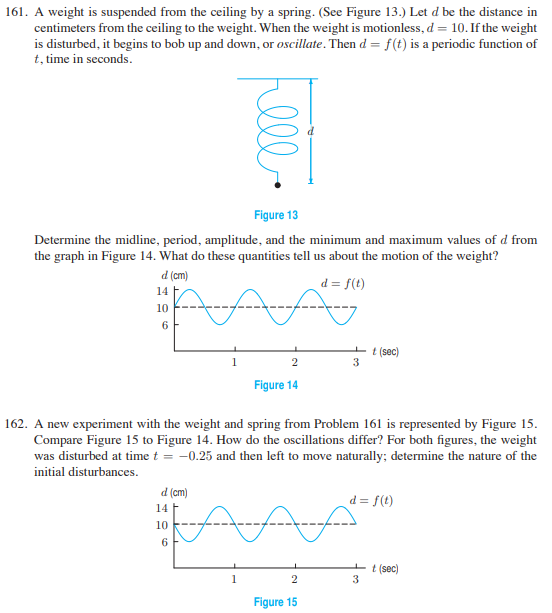d (cm) 14 E. d = f(t) 10 6 + t (sec) 1 Figure 14 162. A new experiment with the weight and spring from Problem 161 is represented by Figure 15. Compare Figure 15 to Figure 14. How do the oscillations differ? For both figures, the weight was disturbed at time t = -0.25 and then left to move naturally; determine the nature of the initial disturbances. d (cm) d = f(t) 14 10 6. t (sec) 3 Figure 15
d (cm) 14 E. d = f(t) 10 6 + t (sec) 1 Figure 14 162. A new experiment with the weight and spring from Problem 161 is represented by Figure 15. Compare Figure 15 to Figure 14. How do the oscillations differ? For both figures, the weight was disturbed at time t = -0.25 and then left to move naturally; determine the nature of the initial disturbances. d (cm) d = f(t) 14 10 6. t (sec) 3 Figure 15
Question
Please show all work. (Solve only 162)

Transcribed Image Text:d (cm)
14 E.
d = f(t)
10
6
+ t (sec)
1
Figure 14
162. A new experiment with the weight and spring from Problem 161 is represented by Figure 15.
Compare Figure 15 to Figure 14. How do the oscillations differ? For both figures, the weight
was disturbed at time t = -0.25 and then left to move naturally; determine the nature of the
initial disturbances.
d (cm)
d = f(t)
14
10
6.
t (sec)
3
Figure 15
Expert Solution
This question has been solved!
Explore an expertly crafted, step-by-step solution for a thorough understanding of key concepts.
This is a popular solution!
Trending now
This is a popular solution!
Step by step
Solved in 2 steps with 2 images
